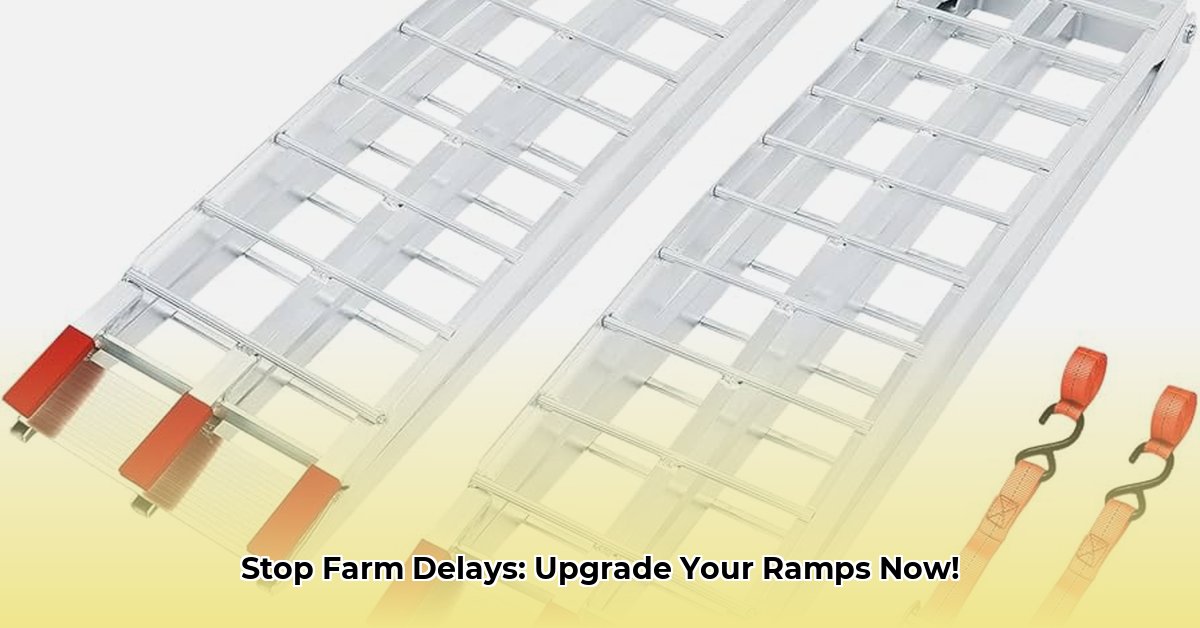
Investing in the right aluminum loading ramps can significantly improve your farm's efficiency, safety, and sustainability. This guide provides a step-by-step process for selecting and utilizing aluminum ramps, focusing on practical advice and long-term cost savings. We'll explore factors like weight capacity, ramp length, material quality, and safe usage practices, helping you make an informed decision. For help determining the right equipment size for your needs, check out this helpful guide on tractor sizing.
Choosing the Right Aluminum Loading Ramps
Selecting the appropriate ramps involves careful consideration of several key factors to ensure safety, efficiency, and longevity. Failing to properly assess these factors could result in costly repairs, equipment damage, or even injuries.
Weight Capacity: Matching Ramps to Your Equipment
The most critical factor is weight capacity. Incorrectly estimating this could lead to catastrophic ramp failure. Always choose ramps with a weight capacity significantly exceeding the heaviest piece of equipment you intend to load. Here's a sample comparison of models from Tractor Supply (note: prices and availability are approximate and subject to change; always verify current details on the Tractor Supply website^{1}https://www.tractorsupply.com/):
| Model | Weight Capacity (lbs) | Length (ft) | Approximate Price (USD) | Notes |
|---|---|---|---|---|
| Reese Towpower Arch Ramp | 1500 | 7.8 | $200 | Suitable for ATVs and smaller equipment |
| Farmhand Aluminum Ramps | 2500 | 10 | $350 | Heavier-duty option for larger machinery. |
| Titan Steel Ramps | 3000 | 8 | $400 | Stronger steel option; consider the increased weight. |
Don't forget to factor in the weight of any additional attachments or implements. "Overestimate rather than underestimate," advises Dr. Emily Carter, Agricultural Engineering Professor at State University. "A failed ramp can cause serious damage and injury."
Ramp Length and Angle: Safety and Ease of Use
Ramp length directly impacts the angle of incline. A longer ramp creates a gentler slope, improving safety and reducing the risk of damage to equipment. However, longer ramps require more storage space. Shorter ramps are more portable but necessitate a steeper incline, potentially increasing the risk of accidents. Visual aids, such as those often found on the Tractor Supply website, can be helpful in visualizing the ideal ramp angle for your equipment and space.
Diagram illustrating gentle vs steep incline would be beneficial here.
Material Quality and Durability: Long-Term Cost Effectiveness
Aluminum is a popular choice for loading ramps due to its lightweight yet robust nature. However, not all aluminum is created equal. Look for ramps constructed from high-quality, heavy-duty aluminum alloys designed to withstand the rigors of farm use. While the initial cost of a durable ramp might be higher, the extended lifespan and reduced need for replacements translate into significant long-term cost savings. "Investing in quality materials translates to lower long-term expenses," notes John Miller, Farm Manager at Green Acres Farm. "It's a sound economic decision."
Sourcing Sustainable Aluminum: Environmental Responsibility
Consider ramps made from recycled aluminum to minimize your environmental footprint. Sustainable sourcing practices reduce the overall environmental impact of your farm operations. Check product descriptions on Tractor Supply's website or contact customer service to enquire about the aluminum sourcing for specific models.
Safe and Efficient Ramp Usage: Best Practices
Safe usage is paramount to prevent accidents and injuries. Adhere to these guidelines meticulously:
- Level Surface: Ensure the ramp is placed on a stable, level surface before loading any equipment. Uneven ground increases instability and the risk of accidents.
- Even Weight Distribution: Distribute the weight of the equipment evenly across the ramp's surface to prevent tipping or uneven stress.
- Controlled Movement: Load and unload equipment slowly and deliberately, avoiding abrupt movements or sudden stops that can jar the equipment or the ramp.
- Spotter Assistance: For larger or heavier pieces of equipment, using a spotter to guide the equipment onto and off the ramp is highly recommended.
- Regular Inspection: Inspect the ramps before each use, checking for any damage, cracks, or loose parts. Address any issues immediately.
- Proper Storage: Store ramps indoors to protect them from the elements and prevent corrosion. Secure them properly during transport.
Long-Term Sustainability and Cost Savings
Investing in high-quality aluminum loading ramps offers numerous long-term benefits.
- Reduced Fuel Consumption: Lightweight aluminum ramps lessen the strain on your vehicles—saving fuel over time.
- Increased Efficiency: Faster, safer loading and unloading translate to increased productivity.
- Extended Equipment Lifespan: Reduced wear and tear on your equipment from gentler loading and unloading.
- Improved Safety: A safer work environment minimizes accidents and reduces insurance costs.
Conclusion
Choosing the correct aluminum loading ramps is crucial for boosting farm efficiency and sustainability. By carefully considering the factors outlined in this guide, you can make an informed decision, ensuring safe, efficient, and cost-effective farm operations for years to come. Remember to always consult the manufacturer's instructions and safety guidelines for optimal performance and longevity.